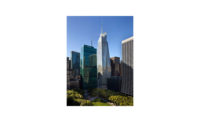Though computational tools promise someday to make fabrication almost automatic for formally complicated projects like the BMW Welt, the construction industry hasn’t quite reached that point. “The decision about how to fabricate [now] comes at the end of the process,” said Fabian Scheurer, a founder of Designtoproduction, a Zurich-based consulting firm that helps design teams realize geometrically complex projects. Scheurer’s firm worked on Zaha Hadid’s Nordpark funicular stations in Innsbruck, preparing data for the computer-controlled machines that manufactured the 2,500 different polyethylene profiles that connect the stations’ doubly curved glass cladding to the steel sub-structures. “There is not enough research,” Scheurer said. “Designers should understand manufacturing, but manufacturers should also understand the design process in order to exploit new markets.”
Though most of the conference presentations focused on individual components or buildings, a few speakers discussed the use of parametric tools for urban-scale design and analysis. London-based Judit Kimpian, head of sustainability and advanced modeling at the multi-disciplinary design firm Aedas, presented a dynamic model it has developed in collaboration with the construction management and cost consulting firm Davis Langdon. The model can be used to explore the impact of tall buildings on their environments. It shows, for example, that if mass transit infrastructure is not developed in tandem with a super-tall building, much of the surrounding space must be devoted to parking. Aedas hopes that the tool will help it work with clients to make critical early design decisions. Said Kimpian: “The decisions that most effect sustainability are typically made in the first one percent of the project schedule.”









Post a comment to this article
Report Abusive Comment